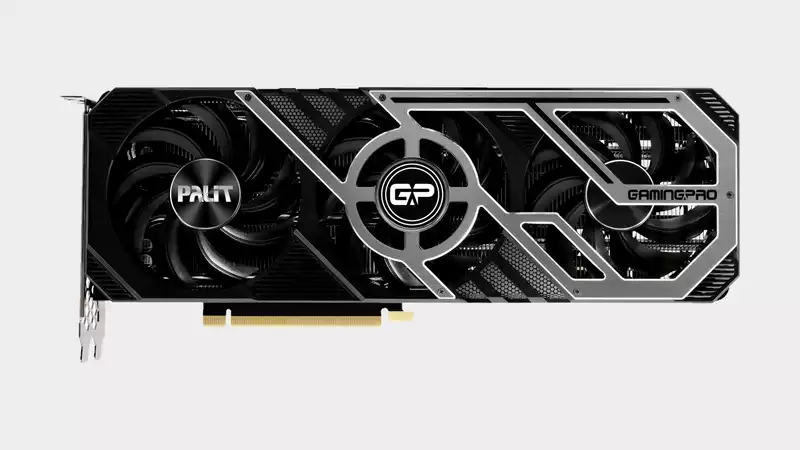Nvidia has set the bar pretty high with the RTX 3080 Founder's Edition, so AIB has to do something pretty special to get you to buy their card instead of Nvidia's. In the case of the Palit GeForce RTX 3080 GamingPro OC you get an incredibly long title, a chunky triple fan cooler, and a slightly higher GPU boost clock.
No kidding, the card's boost clock is 1,740 MHz, while the Founders Edition's top clock is 1,710 MHz, a 30 MHz, or 1.75 percent, increase. With a boost clock of 1,740 MHz, the GPU will not run at this frequency all the time, unless the GPU is kept cool with a traditional triple-fan setup. However, actual performance will be discussed later.
Returning to the card specifications, the memory clocks are the same, obviously the same core configuration as the Founder's Edition, and everything else is pretty much as expected. The big difference is the size of the card: the Founder's Edition is a relatively compact unit, while this Palit card is a huge, sprawling triple-slot (2.7 slots wide to be exact). At 294 mm long and 112 mm high, it should not be applied if you have a smaller case. In any case, please take out your tape measure and check it before purchasing.
The actual styling of the card is industrial, with lots of mesh and grills. The monochrome theme works well enough on the front of the card, but perhaps the most noticeable feature is the cardboard box packing material-style back plate. With mounting hardware, the center portion of the card would light up. Not a bad look, but it may not be to everyone's taste.
When in use, the triple fans do a good job of cooling the core. In normal gaming, the temperatures range from 64-68°C at normal settings; in a one-hour run of Geeks3D FurMark, the temperature peaked at 73°C. Frankly, normal games will run at much lower temperatures than this, even for extended periods of time.
Even when battling these temperatures, the triple-fan design keeps noise levels fairly low, and while not silent, it would be difficult to hear the card mixed in with other fan noises in a standard gaming rig. Also, if you are not running benchmarks specifically designed to put maximum stress on the card, you will hardly notice it at all; Palit also offers 0dB technology, which turns the fan off completely when you are not gaming.
Palit states that the card will consume 320W and recommends a 750W PSU, which seems reasonable; if you are overclocking a Core i9 10900K and have a rich hard drive, you will need more power.
As for performance, there is not much difference between any of the RTX 3080s we have seen so far. At the resolutions where we really want to run this card - 1440p and 4K - it will trade a couple of frames against the Founder's Edition and the Asus TUF Gaming RTX 3080 OC, depending on the game in question.
There have also been reports of the RTX 3080 falling over, but we have no concerns about its construction, as this Palit card has been rock solid in our extensive benchmarking. The latest Nvidia driver update appears to have fixed these issues by suppressing the GPU boost feature. This should not be a concern as it has little to no effect on frame rates.
So what if you are not going to make a purchase decision based on performance? Well, this card is quiet, runs cool, and looks good. There is absolutely nothing wrong with this card, but there is obviously another factor: availability.
As of this writing, the RTX 3080 is not yet available anywhere. At that point, assuming you're actually in the market to buy an RTX 3080, you're probably going to grab whatever you can find. If it happens to be this Palit, you will be happy.
But given the choice, would we recommend this over the Founder's Edition? However, I like the look of Nvidia's cards, so I would give the edge to the Founder's Edition RTX 3080. But if this is the only option, I would jump at the chance.
.

Comments